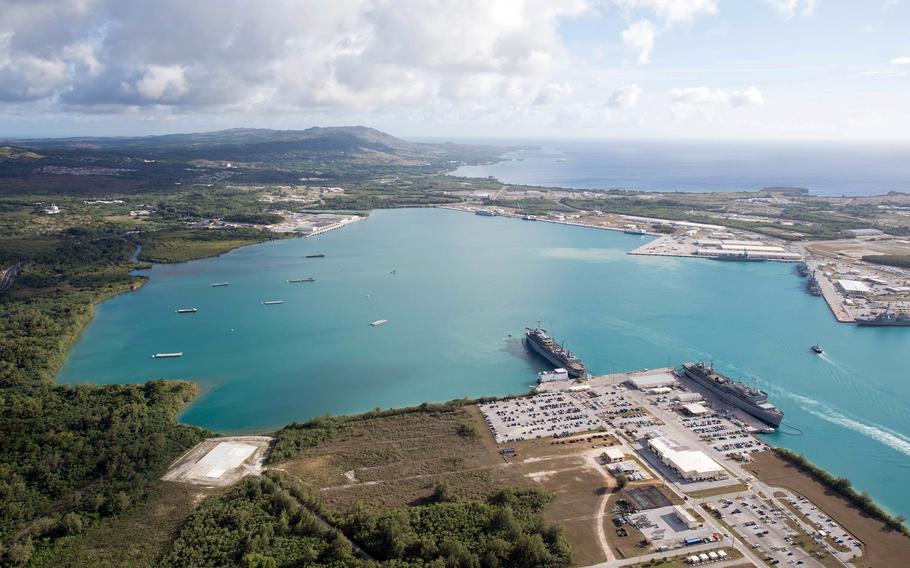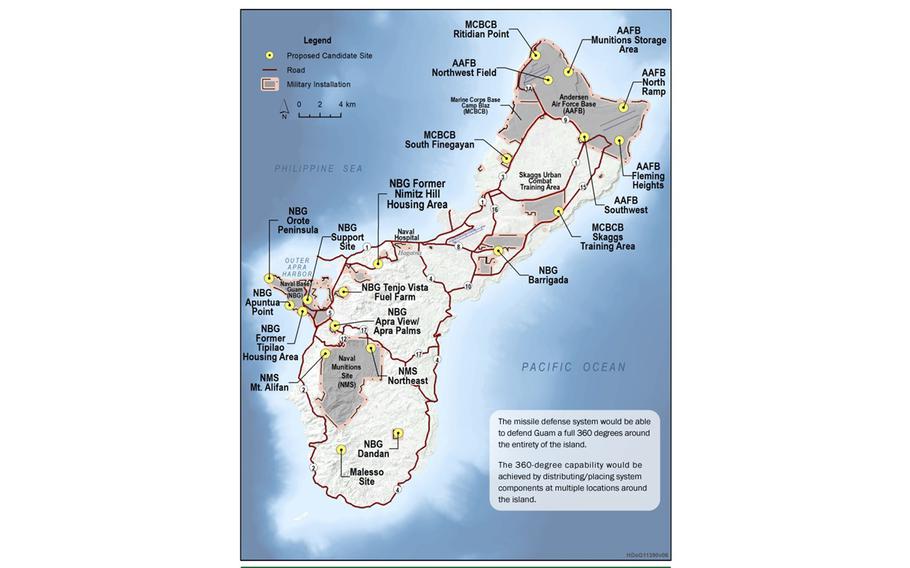
An aerial view of Naval Base Guam shows several vessels moored at Apra Harbor, March 15, 2018. (Stacy Laseter/U.S. Navy)
The U.S. government is considering nuclear microreactors to power its Pacific-island fortress on Guam.
Legislation being considered by the Senate and due to be passed by year’s end directs a briefing on military nuclear microreactors, according to an executive summary of the National Defense Authorization Act, greenlit on June 22 by the Senate Armed Services Committee.
The executive summary doesn’t specify who would be briefed but directs it to focus on “the potential for using modular microreactors to supplement power generation in Guam.”
The island citadel is home to a burgeoning garrison of military personnel from every service branch.
Andersen Air Force Base has long been a linchpin of U.S. air power in the Indo-Pacific while Guam’s harbor hosts attack submarines and port calls by aircraft carrier strike groups. Marine Corps Base Camp Blaz, which opened in January but is still under construction, will accommodate thousands of Marines relocating from Okinawa.
Meanwhile, the Army, which operates a Terminal High Altitude Area Defense, or THAAD, system on Guam, will expand its footprint under plans for 360-degree air and missile defense to combat potential Chinese or North Korean strikes.
The defense funding bill requires a report on the capacity of infrastructure, resources and personnel available on Guam to meet U.S. Indo-Pacific Command strategic objectives.
Guam’s delegate to Congress, James Moylan, a member of the House Armed Services Committee, is unaware of discussions about potential nuclear power on Guam, according to his statement in The Guam Daily Post on Tuesday.
"This is the first we are reading of any discussions associated with nuclear reactors to supplement power on Guam," he wrote. "Since this was discovered in the Senate's version of the NDAA, no discussions or inquiries were made with our office."
The U.S. government is funding the construction of a prototype mobile nuclear microreactor as part of Project Pele, according to a Defense Department statement on April 13, 2022.
The microreactor, assembled and initially operated at Idaho National Laboratory, aims to deliver 1-5 MW of electrical power for a minimum of three years of full power operation, according to the statement.
The Defense Department has contracted to build the $300 million prototype by 2024, according to a World Nuclear News report on June 9, 2022.
In the 1960s and 1970s, the Army operated small nuclear power plants in Wyoming, Antarctica, Greenland and in the Panama Canal Zone, according to a 2018 Army report on potential future use of such plants.
The report analyzed the Navy and Air Force as potential users of mobile nuclear power plants on Guam. Other spots in the Indo-Pacific examined as potential locations for the microreactors included the Indian Ocean island of Diego Garcia and the Pacific atoll of Kwajalein.
Environmental assessment of as many as 20 sites for the Enhanced Integrated Air and Missile Defense System are underway across Guam.

Environmental assessments for as many as 20 sites for the Enhanced Integrated Air and Missile Defense System are underway across Guam. (Missile Defense Agency)
Large amounts of electricity may be needed to power the new missile defense system on the 212-square-mile island, although its power requirements are uncertain, according to Leland Bettis, director of the Guam-based Pacific Center for Island Security.
The Missile Defense Agency hasn’t specified which sites earmarked for missile defense are power sources and which are command and control facilities or where launchers might be, Bettis told Stars and Stripes by phone Wednesday.
“Nuclear power might be an option for supporting the power grid in Guam,” he said, before bringing up concerns about it being used for military operations.
“If one of those reactors is used to power a forward operating base and it’s targeted in a conflict, it could present an environmental problem,” Bettis said.
Likewise, spreading missile defense sites across Guam could pose risks to the community in the event of conflict, he added.